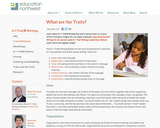
This article details the key qualities of strong writing.
- Subject:
- English Language Arts
- Material Type:
- Student Guide
- Provider:
- Education Northwest
- Author:
- Education Northwest
- Date Added:
- 04/23/2019

This article details the key qualities of strong writing.

This resource accompanies our Rethink 6th Grade ELA course. It includes ideas for use, ways to support exceptional children, ways to extend learning, digital resources and tools, tips for supporting English Language Learners and students with visual and hearing impairments. There are also ideas for offline learning.

This parent guide supports parents in helping their child at home with the 6th grade English Language Arts content.
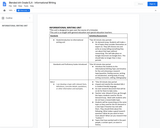
Students will learn the components of an informational essay. Through modeling, mini-lessons and multiple opportunities for practice and feedback, students will go through the writing process to produce an informational essay on the topic of their choice.

Students will read a text and then they will demonstrate their new vocabulary knowledge through appropriate use of the words in context and with accompanying illustrations. They will create of an ABC book through individual and small-group activities. Students will take an active role in their learning by identifying the content area vocabulary they want to research. This lesson can be implemented in any content classroom.

The Adventurers of Sojourner presents a third-person narrative account of the Mars Pathfinder mission, which included the deployment of a small science rover named Sojourner. In this CCSS lesson, students will explore this history through text dependent questions, academic vocabulary, and writing assignments.
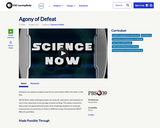
This video clip is meant to serve as a writing or discussion prompt during a unit on forces and motion. This can be used at varied grade levels, with the expectation that student responses would be more complex in higher grade levels.

In Ray Bradbury's “All Summer in A Day†takes place on the planet Venus in a future world where people have come to set up a civilization. In this CCSS lesson students will explore this fiction story through text dependent questions, academic vocabulary, and writing assignments.
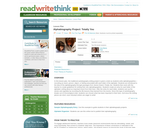
In this lesson plan, the traditional autobiography writing project is given a twist as students write alphabiographies—recording an event, person, object, or feeling associated with each letter of the alphabet. Students are introduced to the idea of the alphabiography through passages from James Howe's Totally Joe. Students then work with the teacher to create guidelines for writing their own alphabiographies. Students create an entry for each letter of the alphabet, writing about an important event from their lives. After the entry for each letter, students sum up the stories and vignettes by recording the life lessons they learned from the events. Since this type of autobiography breaks out of chronological order, students can choose what has been important in their lives. And since the writing pieces are short, even reluctant writers are eager to write!

This lesson was designed to help students gain social studies/history content knowledge by using textual evidence to answer text-dependent questions.In this CCSS lesson, students will explore this history through text dependent questions, academic vocabulary, and writing assignments.
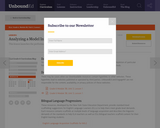
In this lesson, students will research about overfishing/sustainable fishing methods, case-studies of depletion of particular fish, and suggestions of how to buy fish that have been caught using sustainable methods.
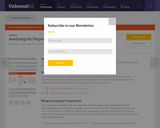
In this lesson, students are introduced to the Newspaper Article Rubric.

In this activity, students will work in collaborative groups to create 9M x 9M models of plant and animal cells. Class population can be split into 2 or 4 groups, with half the students constructing animal cells and the other half constructing plant cells. Students must organize and assign duties, provide materials for this activity, and write a written report. They will also give "Cell Tours" to other students and/or classroom guests.
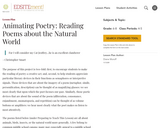
The purpose of this project is two-fold: first, to encourage students to make the reading of poetry a creative act; and, second, to help students appreciate particular literary devices in their functions as semaphores or interpretive signals. Those devices that are about the imagery of a poem (metaphor, simile, personification, description) can be thought of as magnifying glasses: we see most clearly that upon which the poet focuses our gaze. Similarly, those poetic devices that are about the sound of the poem (alliteration, consonance, enjambment, onomatopoeia, and repetition) can be thought of as volume buttons or amplifiers: we hear most clearly what the poet makes us listen to most attentively.
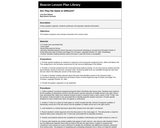
In this lesson, students will synthesize and separate collected information using a graphic organizer.
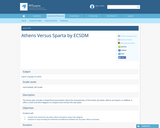
Students will: compare and contrast the city-states, Athens and Sparta, using a Venn diagram. compose an essay including the similarities and differences between the city-states, Athens and Sparta.
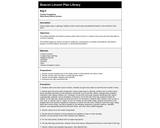
Using a paper bag or a gift bag, students create a book report providing information on the elements of the book.

The short story, titled “Becky and the Wheel-and-Brake Boys,†is about how Becky desperately wants to own a bike despite the resistance she is met with from her mother and Granny-Liz. In this CCSS lesson students will explore this short story through text dependent questions, academic vocabulary, and writing assignments.

This story, set in 1820s Austria, is a series of letters written between a young boy, Christoph, who lives in Vienna and his uncle, a music student who lives in Salzburg. In the letters, Christoph tells his uncle of the strange gentleman, Ludwig van Beethoven, who has rented a room in the boy’s home. In this CCSS lesson students will explore this story through text dependent questions, academic vocabulary, and writing assignments.
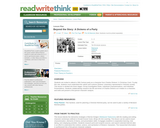
For this lesson, students are invited to attend a 19th Century party as a character from Charles Dickens' A Christmas Carol. To play this role, students must understand the values and customs Dickens' characters represented in Victorian society. This lesson is divided into three stages: Group Investigative Roles, Individual Characterizations, and Individual Presentations. Students collaboratively research the life and times of Charles Dickens as it relates to a character, and write and present a first-person character analysis.